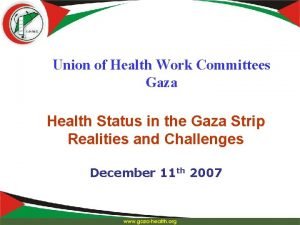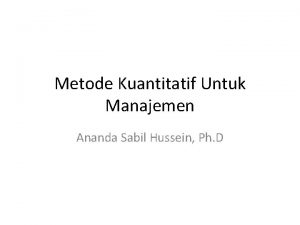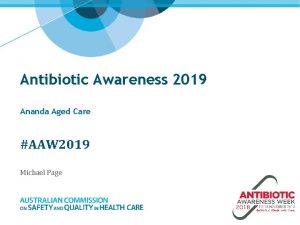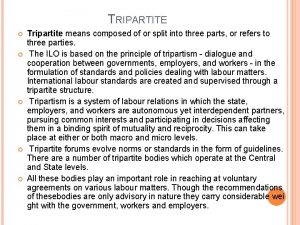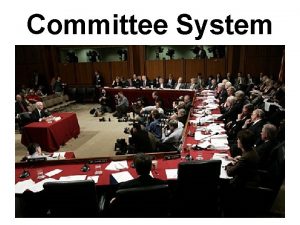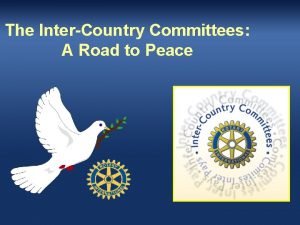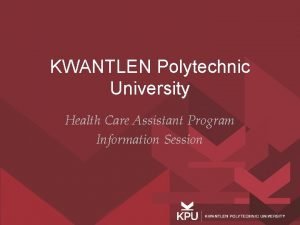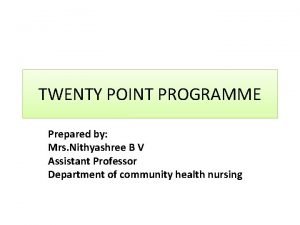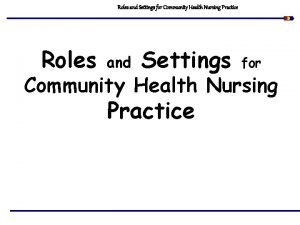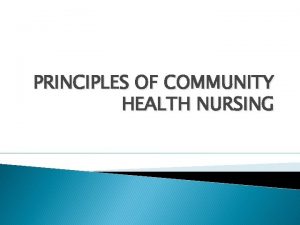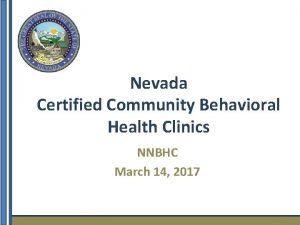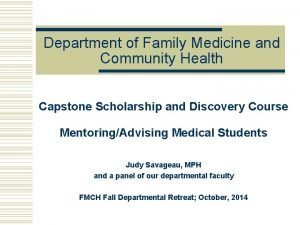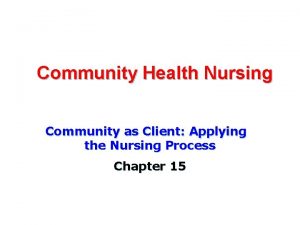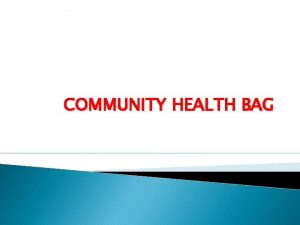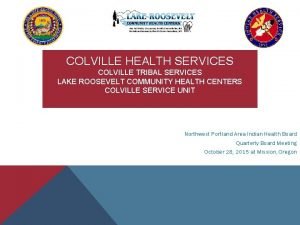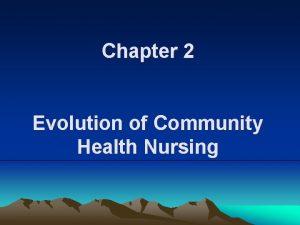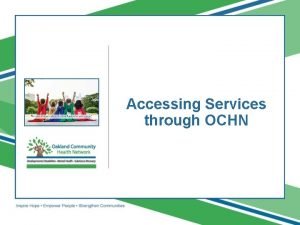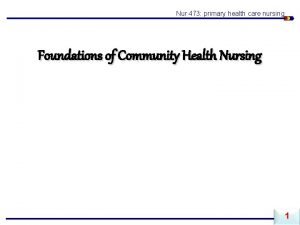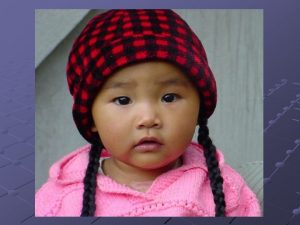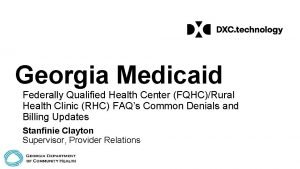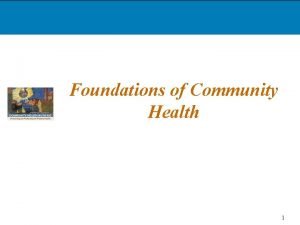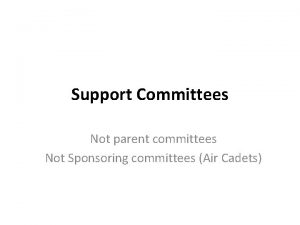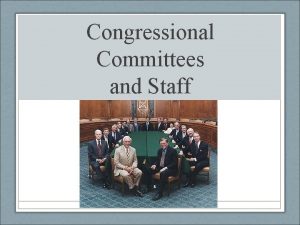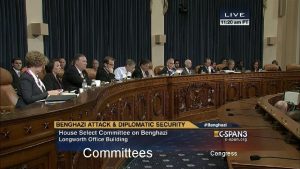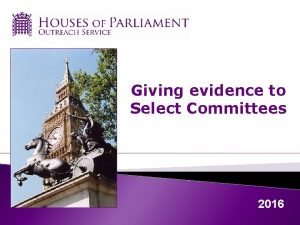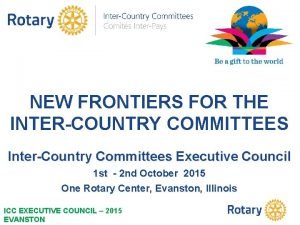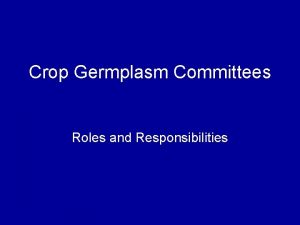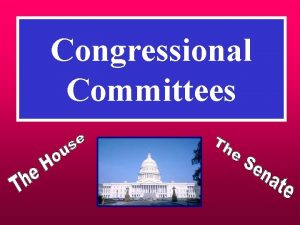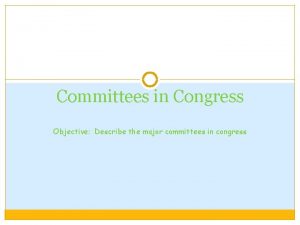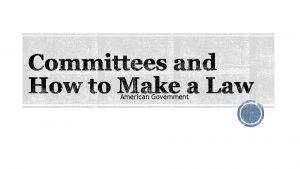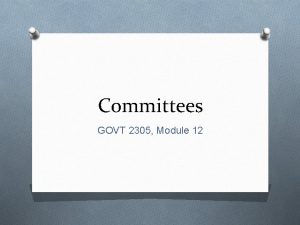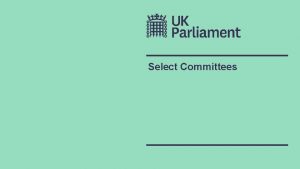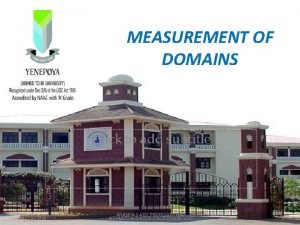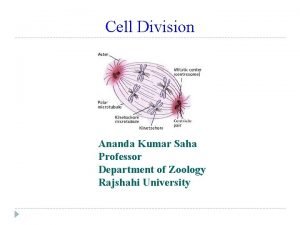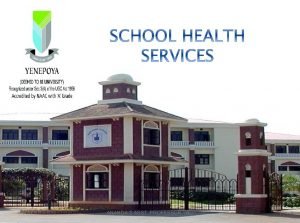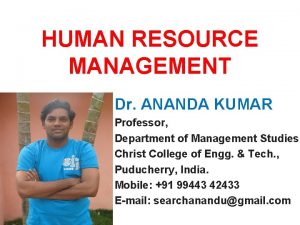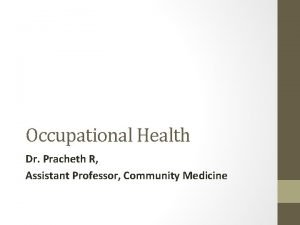HEALTH COMMITTEES MR ANANDA S ASSISTANT PROFESSOR COMMUNITY









































- Slides: 41

HEALTH COMMITTEES MR. ANANDA. S ASSISTANT PROFESSOR COMMUNITY HEALTH NURSING YENEPOYA NURSING COLLEGE

LEARNING OBJECTIVES At the end of the class the student will be able toØExplain in details about various committees and their recommendation

HEALTH COMMITTEES • The guide-lines for national health planning were provided by a various committees of experts have been appointed by the Government of India from time to review the existing health situation and recommend measures for further action.

The important committees are • • • Bhore Committee, 1946 Mudaliar Committee, 1962 Chadah Committee, 1963 Mukerji Committee, 1965 Mukerji Committee, 1966 Jungalwalla Committee, 1967 Kartar Singh Committee, 1973 Shrivastav Committee, 1975 Rural health scheme, 1977

Bhore Committee, 1946 • The Government of India in 1943 appointed the Health Survey and Development Committee with Sir Joseph Bhore as Chairman , Popularly known as Bhore Committee • To survey then existing position regarding the health conditions and health organization in the country, and to make recommendations for the future development.

• Committee members met regularly for 2 years and submitted in 1946 its famous report which runs into 4 volumes. • The Committee put forward, for the first time, comprehensive proposals for the development of a national programme of health services for the country.

Recommendations 1. Integration of preventive and curative services at all administration level 2. Development of Primary health centres in 2 stages. • In short-term measure PHC in rural area should include population of 40, 000 with a secondary health centre to serve as a supervisory, coordinating and referral institution.


For each PHC, 2 Medical Officer 4 Public Health Nurses 1 Nurse 4 Midwives 4 Trained Dais 2 Sanitary Inspectors 2 Health Assistants 1 Pharmacist 15 Other Class Iv Employees

• long-term programme (also called the 3 million plan) Setting up primary health units with 75 -bedded hospitals for each 10, 000 to 20, 000 population and secondary units with 650 -bedded hospitals, and district hospitals with 2, 500 beds

3 ) Major changes in medical education which includes 3 month's training in preventive and social medicine to prepare "social physicians".

Mudaliar Committee, 1962 • In 1959, the Government of India appointed another Committee known as "Health Survey and Planning Committee", popularly known as the Mudaliar Committee • Dr. A. L. Mudaliar as Chairman -to survey the progress made in the field of health since submission of the Bhore Committee's Report and to make recommendations for future development and expansion of health services.

• The Mudaliar Committee found the quality of services provided by the primary health centres inadequate, • Advised strengthening of the existing primary health centres before new centres were established. • It also advised strengthening of subdivisional and district hospitals - function as referral centres

Recommendations • • • Consolidate advances : first 2 five year plans Strengthen District Hospitals: specialists Each PHC not more than 40, 000 Improve quality in PHC Integrate medical and health services Constitution of All India Health Services

Chadah Committee, 1963 • In 1963, a Committee was appointed by the Government of India, under the Chairmanship of Dr. M. S. Chadah, then Director General of health Services to study the arrangements necessary for the maintenance phase of the National Malaria Eradication Programme.

RECOMMENDATIONS • "Vigilance" operations in respect of the NMEP should be the responsibility of the general health services • “ Malaria Vigilance operations through monthly home visits should be implemented by basic health workers. • One basic health worker per 10, 000 population

• BHW to serve as MPHW for family planning and vital statistics and malaria vigilance. • FPHA to supervise 3 -4 BHW

Mukerji committee, 1965 Within a couple of years of implementation of the Chadah Committee's recommendations by some states, § it was realised that the basic health workers could not function effectively as multipurpose workers. § So, malaria operations and family planning programme suffered §

• This subject came up for discussion at a meeting of the Central Health Council in 1965 • Set up a committee known as "Mukerji Committee, 1965" under the Chairmanship of Shri Mukerji, was appointed to review the strategy for the family planning programme.

Recommendations • The Committee recommended separate staff for the family planning programme. • The family planning assistants were to undertake family planning duties only. • The basic health workers were to be utilized for purposes other than family planning. • The Committee also recommended to delink the malaria activities from family planning The recommendations were accepted by the Government of India.

Mukerji committee, 1966 • As the states were finding it difficult to take over the whole burden of the maintenance phase of malaria. • Other mass programmes like family planning, smallpox, leprosy, trachoma, etc. due to paucity of funds, • This matter came up for discussion at a meeting of the Central Council of Health held in Bangalore in 1966.

• The Council recommended that these and related questions may be examined by a committee of Health Secretaries, under the Chairmanship, Shri Mukerji. • The Committee worked out the details of the BASIC HEALTH SERVICE • Recommended basic health service at PHC Level

Jungalwalla committee, 1967 • The Central Council of Health at its meeting held in Srinagar in 1964. • Taking note of the importance and urgency of integration of health services, and elimination of private practice by government doctors, appointed a Committee known as the "Committee on Integration of Health Services“ under the Chairmanship of Dr. N. Jungalwalla,

§ To examine the various problems including those of service conditions and submit a report to the Central Government in the light of these considerations. The report was submitted in 1967.

• The Committee defined "integrated health services" as: (i) a service with a unified approach for all problems instead of a segmented approach for different problems; and (ii) medical care of the sick and conventional public health programmes functioning under a single administrator

• The Committee recommended integration from the highest to the lowest level in the services, organization and personnel.

RECOMMENDATIONS ü Unified cadre ü Common seniority ü Recognize extra qualifications ü Equal pay for equal work ü Special pay for specialized work ü No private practice and good service condition

Kartar Singh committee, 1973 • The Government of India constituted a Committee in 1972 known as "The Committee on Multipurpose Workers under Health and Family Planning" under the Chairmanship of Kartar Singh,

Ø To study and make recommendation on : (a) the structure for integrated services at the peripheral and supervisory levels; (b) the feasibility of having multipurpose, bipurpose workers in the field: (c) the training requirements for such workers; and (d) the utilization of mobile service units set up under family planning programme The Committee submitted its report in September 1973.

Recommendations • (a)Present Auxiliary Nurse Midwives to be replaced by the newly designated "Female Health Workers", and the present-day Basic Health Workers, Malaria Surveillance Workers, Vaccinators, Health Education Assistants and the Family Planning Health Assistants to be replaced by "Male Health Workers".

• (b) The Programme for having multipurpose workers to be first introduced in areas where malaria is in maintenance phase and smallpox has been controlled. • (c) For proper coverage, there should be one primary health centre for a population of 50, 000

• (d) Each primary health centre should be divided into 16 sub-centres each having a population of about 3, 000 to 3, 500. • (e) Each sub-centre to be staffed by a team of one male and one female health worker • (f) There should be a male health supervisor to supervise the work of 3 to 4 male health workers; and a female health supervisor to supervise the work of 4 female health workers

• (g) The present-day lady health visitors to be designated as female health supervisors and • (h) The doctor in charge of a primary health centre should have the overall charge of all the supervisors and health workers in his area.

• The recommendations of the Kartar Singh Committee were accepted by the Government of India to be implemented during the Fifth Five year Plan. (1974 -1979)

Shrivastav committee, 1975 • The Government of India in the Ministry of Health and Family Planning in November 1974 set up a 'Group on Medical Education and Support Manpower' popularly known as the Shrivastav Committee. (1) to devise a suitable curriculum for training a cadre of health assistants (2) to suggest steps for improving the existing medical educational processes

• The Group submitted its report in April 1975.

RECOMMENDATIONS • ( 1) Creation of bands of para-professional and semi-professional health workers from within the community itself (e. g. , school teachers, postmasters, gram sevaks) to provide simple, promotive, preventive and curative health services. • (2) Establishment of 2 cadres of health workers, namely - multipurpose health workers and health assistants between the community level workers and doctors at the PHC;

• (3) Development of a 'Referral Services Complex. • (4) Establishment of a Medical and Health Education Commission for planning and implementing the reforms needed in health and medical education

Rural health scheme, 1977 • The most important recommendation of the Shrivastav Committee was that primary health care should be provided within the community itself through specially trained workers • The basic recommendations of the Committee were accepted by the Government in 1977 • which led to the launching of the Rural Health Scheme

• The programme of training of community health workers was initiated during 1977 -78. • Steps were also initiated • (a) involvement of medical colleges in the total health care of selected PHCs with the objective of reorienting medical education to the needs of rural people; and (b) reorientation training of multipurpose workers engaged in the control of various communicable disease programmes.

RECAPITULATION 1. The Bhore committee is also known as ……………… 2. The Mudaliar committee is also known as………… 3. The Rural health scheme was introduce in the year …………. 4. The kartar Singh committee was appointed in the year …………
 Health work committees
Health work committees Ananda gunawardena
Ananda gunawardena Ananda sabil hussein
Ananda sabil hussein Ananda aged care
Ananda aged care Promotion from associate professor to professor
Promotion from associate professor to professor Fok ping kwan
Fok ping kwan There are....tripartite committees at the national level..
There are....tripartite committees at the national level.. Committees of correspondence
Committees of correspondence Examples of select committees
Examples of select committees Compare the functions of joint and conference committees.
Compare the functions of joint and conference committees. Chapter 5 lesson 1 congressional membership
Chapter 5 lesson 1 congressional membership Committees of correspondence
Committees of correspondence Rotary intercountry committees
Rotary intercountry committees Effective safety committees
Effective safety committees Effective safety committees
Effective safety committees Role of community health nurse in occupational health
Role of community health nurse in occupational health Kpu health care assistant
Kpu health care assistant Evaluate together in community mobilization
Evaluate together in community mobilization Lenawee county cmh
Lenawee county cmh Van buren community mental health
Van buren community mental health Twenty point program
Twenty point program Example of community health nursing diagnosis statement
Example of community health nursing diagnosis statement Characteristics of the nursing process
Characteristics of the nursing process Roles of a nurse in the community
Roles of a nurse in the community Principal of community health nursing
Principal of community health nursing What are the nursing process
What are the nursing process Nursing care plan hallucinations
Nursing care plan hallucinations Nnbhc
Nnbhc Objectives of national mental health programme
Objectives of national mental health programme Family and community health advisor
Family and community health advisor Nursing diagnosis for community health
Nursing diagnosis for community health Community bag technique definition
Community bag technique definition Colville community health center
Colville community health center Historical development of chn
Historical development of chn Evolution of community health nursing
Evolution of community health nursing Oakland community services
Oakland community services Principal of home visit
Principal of home visit Components of community health nursing
Components of community health nursing Home visiting definition
Home visiting definition Community health evangelism
Community health evangelism Georgia department of community health
Georgia department of community health Eight characteristics of community health nursing
Eight characteristics of community health nursing
